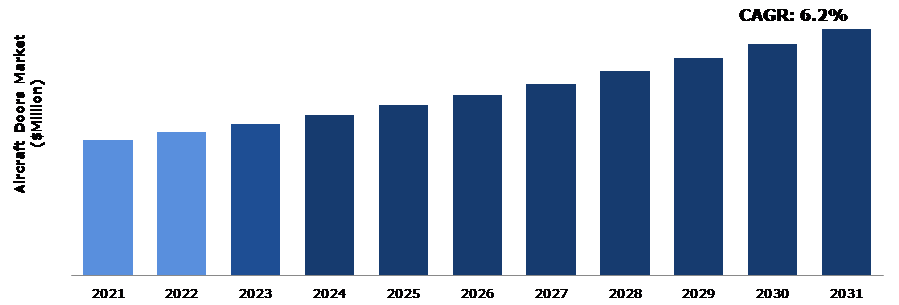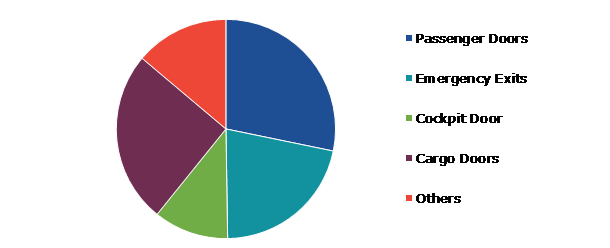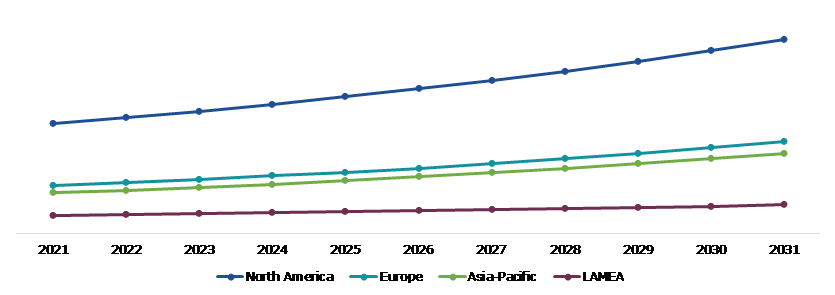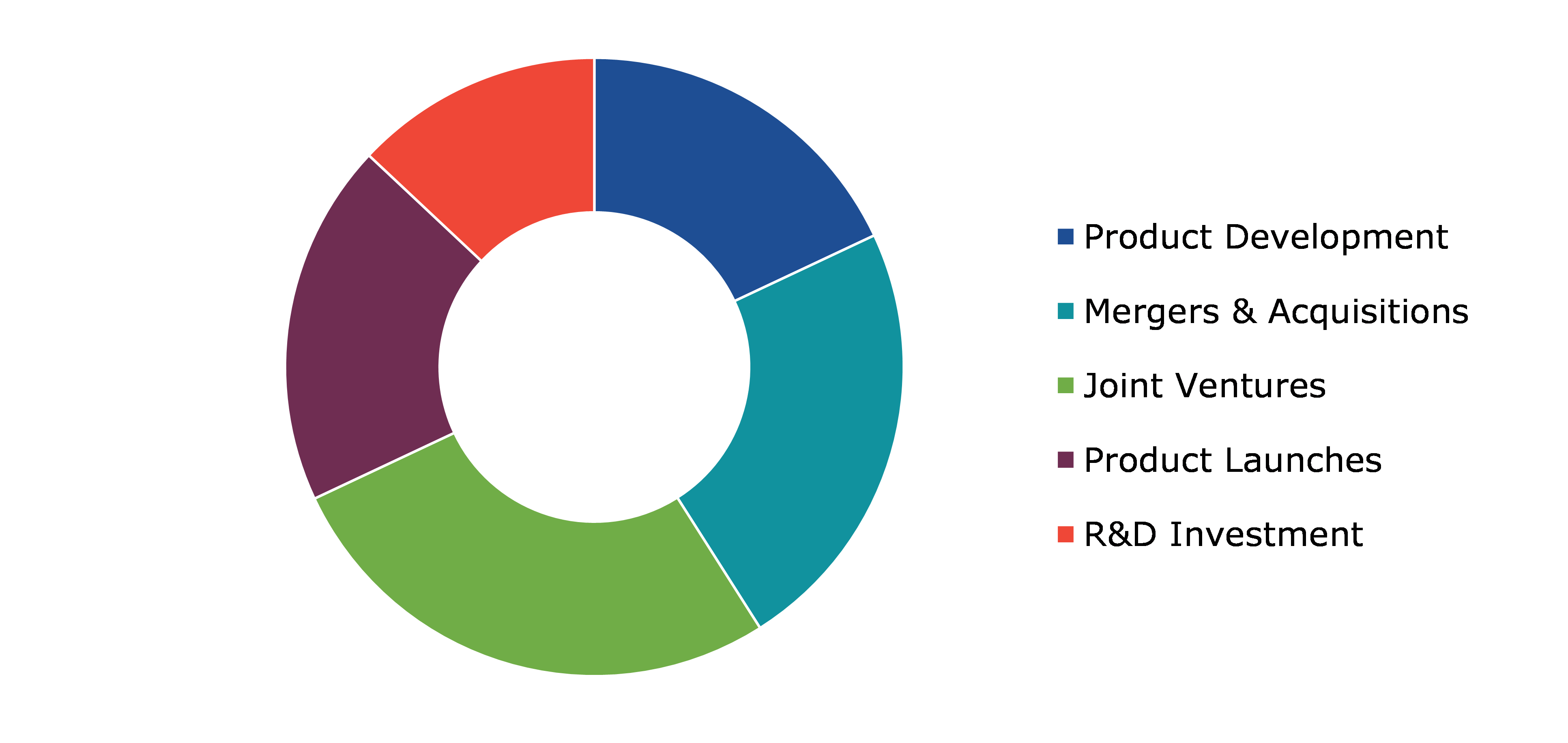Aircraft Doors Market Report
RA02854
Aircraft Doors Market by Door Type (Passenger Doors, Emergency Exits, Cockpit Doors, Cargo Doors, and Others), Aircraft Type (Commercial and Military), End-user (OEM and Aftermarket), and Regional Analysis (North America, Europe, Asia-Pacific, and LAMEA): Global Opportunity Analysis and Industry Forecast, 2022-2031
Global Aircraft Doors Market Analysis
The Global Aircraft Doors Market Size was $4,968.0 million in 2021 and is predicted to grow with a CAGR of 6.2%, by generating a revenue of $9,057.5 million by 2031.
Global Aircraft Doors Market Synopsis
Aircraft doors are meticulously designed and developed to suit the requirements for safety, internal pressure, and access control and management to be installed in various compartments of the aircraft. These doors are built to resist a wide range of heights, temperatures, and bad weather conditions for an extended period of time. The global aircraft doors market is predicted to grow significantly throughout the forecast period, owing to increased aircraft manufacturing as air passenger traffic increases. In addition, authorities' increased attention to replacing outdated aircraft doors is anticipated to fuel market expansion.
High manufacturing costs and fluctuating raw material prices are projected to stymie the expansion of the global aircraft doors market. In addition, the design complexity of aircraft doors manufacturing is anticipated to hinder the aircraft doors market expansion.
The demand for aircrafts in the aviation sector has been fueled by a number of factors, including an increase in the proportion of middle-class households with access to and affordability for air travel, fierce competition among efficient, low-cost carriers, infrastructure development, and a supportive political environment for its expansion. Increased investment by key companies, rising passenger plane demand, and increased government spending on fleet expansion are all projected to generate new opportunities for players in the global aircraft doors market over the forecast period.
According to regional analysis, the North America aircraft doors market accounted for $2,517.8 million in 2021 and is predicted to grow with a CAGR of 5.9% in the projected timeframe.
Aircraft Doors Overview
Aircraft doors serve as the entrance and exit points for passengers. Exit doors are specially developed so that they won't open during flight and won't let in air, disturbing the pressure. On a plane, there are three different kinds of doors: service doors, emergency exits, and exits for passengers. The front, middle, and back regions of a big passenger aircraft are where the passenger doors that are used during boarding are particularly placed. The aircraft doors are also integrated and adapted to meet expanding customer demands while also meeting the industry's growing demands.
COVID-19 Impact on Global Aircraft Doors Market
The COVID-19 pandemic has brought several uncertainties leading to severe economic losses as various businesses across the world came to a standstill. Due to the COVID-19 pandemic, travel restrictions and lockdowns were implemented by the government, which hampered the production of aircrafts around the world. The supply of electrical parts and hydraulic systems used in aircraft doors was significantly impacted. Air travel has decreased as international borders have been closed. Also, more aircrafts are being grounded, and airlines are postponing aircraft deliveries owing to interrupted supply networks. Such challenges are projected to hinder aircraft doors market growth. However, the steps taken by governments in countries as the United States, China, and India to lessen the impact on the aviation industry may create an opportunity for the aircraft doors market to grow in the next years.
Growing Demand for Lightweight Aircraft Doors that Reduce the Overall Weight of Aircraft to Drive Market Growth
The aircraft door is a crucial part of the aircraft, which along with its primary use, is helpful to maintain the pressure inside the aircraft. The market for aircraft doors is expected to be driven by the growing demand for lightweight doors as a result of developments in door technology including improved hydraulics and low weight. Also, it is projected that the growing demand for lightweight aircraft doors from aircraft manufacturing companies to reduce the overall weight of commercial aircraft to increase the fuel efficiency of aircraft is a major factor which is driving the global aircraft doors market in the anticipated time period. For instance, a surge in demand for low-cost airlines is expected to result in more investment opportunities during the estimated period for the market for aircraft doors. For instance, in February 2021 All Nippon Airways launched a new low-cost airline brand with flights connecting Japan with Oceania and Southeast Asia.
To know more about global aircraft doors market drivers, get in touch with our analysts here.
The Cost of Aircraft Doors and Technical Challenges May Hinder the Growth of the Market
The cost of manufacturing aircraft doors is very high. The cost of the technology used in the aircraft door system is higher than that of any another aircraft part. The market revenue may be hampered by technical difficulties with hydraulically powered aircraft doors, such as cargo doors and entry and departure doors. These factors are anticipated to hinder the aircraft doors market share.
Increase in the Number of Passenger and Commercial Aircrafts to Drive Excellent Opportunities
A significant factor anticipated to fuel the growth of the global aircraft doors market is the increase in passenger and commercial aircraft numbers. Globally, expanding tourism and a thriving aviation industry are driving the demand for passenger planes, which is likely to drive up the need for secure, lightweight aircraft doors. Players such Boeing, Airbus, and many others are concentrating on growing their customer base through the introduction of new products, which is anticipated to help the aircraft doors market growth for aircraft doors. The rise and demand for commercial air travel through the number of passengers traveling to, from, or within India climbed from 79 million in 2010 to 158 million in 2017, more than double. It is anticipated to grow to 520 Mn by 2037. Thus, there has been an 11% increase in passenger traffic growth. The nation's aviation fleet is projected to increase fourfold to roughly 2500 aircraft by 2038 to meet the increased demand. As part of the Ude Desh ka Aam Nagrik (UDAN) program, the government has also promised to construct 100 more airports by 2024. It is also anticipated that the air fleet will grow from 600 to 1200 aircraft. The Middle East's aviation sector is rising due to a huge population of high-net-worth and ultra-high-net-worth individuals. These factors are fueling demand for luxurious, long-range business jets with spacious cabins aircraft jets. All these factors are anticipated to boost the demand for aircraft doors market share.
To know more about global aircraft doors market opportunities, get in touch with our analysts here.
Global Aircraft Doors Market, by Door Type
Based on door type, the market has been divided into passenger doors, emergency exits, cockpit doors, cargo doors, and others. Among these, the passenger doors sub-segment accounted for the highest market in 2021.
Global Aircraft Doors Market Size, by Door Type, 2021
Source: Research Dive Analysis
The passenger doors sub-type is accounted a dominant market share in 2021. Passenger doors are projected to continue to lead the market during the forecast period. The existence of numerous passenger doors in a wide-body aircraft, paired with its lower price, is a critical element contributing to passenger doors' market domination. Passenger doors are substantial and have many mountings for the comfort and safety of the passengers, as well as to keep internal cabin pressures consistent. Passenger and service doors are identical except for size.
Global Aircraft Doors Market, by Aircraft Type
Based on aircraft type, the market has been divided into commercial and military. Among these, the commercial sub-segment accounted for highest revenue share in 2021.
Global Aircraft Doors Market Share, by Aircraft Type, 2021
Source: Research Dive Analysis
The commercial sub-segment accounted a dominant market share in 2021. The global consumer base for commercial aviation has grown dramatically throughout the years. As air passenger traffic grows, the size of the air fleet must grow as well. Furthermore, low-cost carriers have changed the short-haul market by providing consumers with low-cost air travel as a result of their ongoing innovation and cost effectiveness. Airlines, particularly in the Asia Pacific, are earning a significant share of the global aviation market. The increase in new aircraft manufacturing as a result of these factors will boost the aircraft doors market size over the forecast period.
Global Aircraft Doors Market, by End-user
Based on end-user, the market has been divided into OEM and aftermarket. Among these, the OEM sub-segment accounted for highest revenue share in 2021.
Global Aircraft Doors Market Analysis, by End-user, 2021
Source: Research Dive Analysis
The OEM sub-segment accounted a dominant market share in 2021. Due to enormous order backlogs, increases in aircraft deliveries, new aircraft programs, and the replacement of older aircrafts with new fuel-efficient planes are factors predicted to drive the market growth. Aircrafts are fitted with doors such as passenger doors, emergency doors, cargo doors, and landing gear doors before being delivered to airline operators. The doors are installed by OEM operators around the globe to reduce the aircraft delivery time.
Global Aircraft Doors Market, Regional Insights
The aircraft doors market was investigated across North America, Europe, Asia-Pacific, and LAMEA.
Global Aircraft Doors Market Size & Forecast, by region, 2021-2031 (USD Million)
Source: Research Dive Analysis
The Market for Aircraft Doors in North America is the Most Dominant in 2021
The North America aircraft doors market is accounted to show the highest market share in 2031. Due to customers' rising demand for air travel, the industry in North America is anticipated to account for a sizeable revenue share in the worldwide aircraft doors market. Spending by consumers on air travel is rising in North America. Their preference for simple and quick travel attracts new service providers. Consumers' preference for dependable, safe, and less time-consuming travel is gaining traction. As a result, the need for secure and dependable aircraft doors market size is growing.
Competitive Scenario in the Global Aircraft doors Market
Investment, product launch, and agreement are common strategies followed by major market players. For instance, in October 2019, Door Engineering, a global aviation part maker, launched the Premier Door Hydraulic Door System. The hydraulic door system with a single panel is designed to outlive and surpass any other hydraulically driven doors on the market.
Source: Research Dive Analysis
Some of the leading aircraft doors market players are Groupe Latécoère, Aviation Technical Services, Altitude Aerospace, Collins Aerospace, SAAB, FACC AG, Airbus, Hellenic Aerospace Industry, Potez Aéronautique, and Primus Aerospace
| Aspect | Particulars |
| Historical Market Estimations | 2020 |
| Base Year for Market Estimation | 2021 |
| Forecast Timeline for Market Projection | 2022-2031 |
| Geographical Scope | North America, Europe, Asia-Pacific, LAMEA |
| Segmentation by Door Type |
|
| Segmentation by Aircraft Type |
|
| Segmentation by End-user |
|
| Key Companies Profiled |
|
Q1. What is the size of the global aircraft doors market?
A. The size of the global aircraft doors market was over $4,968.0 million in 2021 and is projected to reach $9,057.5 million by 2031.
Q2. Which are the major companies in the aircraft doors market?
A. SAAB, FACC, and AG Airbus are some of the key players in the global aircraft doors market.
Q3. Which region, among others, possesses greater investment opportunities in the near future?
A. The Asia-Pacific region possesses great investment opportunities for investors to witness the most promising growth in the future.
Q4. What will be the growth rate of the Asia-Pacific aircraft doors market?
A. Asia-Pacific Aircraft doors market is anticipated to grow at 7.1% CAGR during the forecast period.
Q5. What are the strategies opted by the leading players in this market?
A. Agreement and investment are the two key strategies opted by the operating companies in this market.
Q6. Which companies are investing more on R&D practices?
A. Groupe Latécoère, Aviation Technical Services Altitude Aerospace are the companies investing more on R&D activities for developing new products and technologies.
1.Research Methodology
1.1.Desk Research
1.2.Real time insights and validation
1.3.Forecast model
1.4.Assumptions and forecast parameters
1.5.Market size estimation
1.5.1.Top-down approach
1.5.2.Bottom-up approach
2.Report Scope
2.1.Market definition
2.2.Key objectives of the study
2.3.Report overview
2.4.Market segmentation
2.5.Overview of the impact of COVID-19 on Global aircraft doors market
3.Executive Summary
4.Market Overview
4.1.Introduction
4.2.Growth impact forces
4.2.1.Drivers
4.2.2.Restraints
4.2.3.Opportunities
4.3.Market value chain analysis
4.3.1.List of raw material suppliers
4.3.2.List of manufacturers
4.3.3.List of distributors
4.4.Innovation & sustainability matrices
4.4.1.Technology matrix
4.4.2.Regulatory matrix
4.5.Porter’s five forces analysis
4.5.1.Bargaining power of suppliers
4.5.2.Bargaining power of consumers
4.5.3.Threat of substitutes
4.5.4.Threat of new entrants
4.5.5.Competitive rivalry intensity
4.6.PESTLE analysis
4.6.1.Political
4.6.2.Economical
4.6.3.Social
4.6.4.Technological
4.6.5.Environmental
4.7.Impact of COVID-19 on aircraft doors market
4.7.1.Pre-covid market scenario
4.7.2.Post-covid market scenario
5.Aircraft Doors Market Analysis, by Door Type
5.1.Overview
5.2.Passenger Doors
5.2.1.Definition, key trends, growth factors, and opportunities
5.2.2.Market size analysis, by region, 2021-2031
5.2.3.Market share analysis, by country, 2021-2031
5.3.Emergency Exits
5.3.1.Definition, key trends, growth factors, and opportunities
5.3.2.Market size analysis, by region, 2021-2031
5.3.3.Market share analysis, by country, 2021-2031
5.4.Others
5.4.1.Definition, key trends, growth factors, and opportunities
5.4.2.Market size analysis, by region, 2021-2031
5.4.3.Market share analysis, by country, 2021-2031
5.5.Cockpit Door
5.5.1.Definition, key trends, growth factors, and opportunities
5.5.2.Market size analysis, by region, 2021-2031
5.5.3.Market share analysis, by country, 2021-2031
5.6.Cargo Doors
5.6.1.Definition, key trends, growth factors, and opportunities
5.6.2.Market size analysis, by region, 2021-2031
5.6.3.Market share analysis, by country, 2021-2031
5.7.Others
5.7.1.Definition, key trends, growth factors, and opportunities
5.7.2.Market size analysis, by region, 2021-2031
5.7.3.Market share analysis, by country, 2021-2031
5.8.Research Dive Exclusive Insights
5.8.1.Market attractiveness
5.8.2.Competition heatmap
6.Aircraft Doors Market Analysis, by Aircraft Type
6.1.Military
6.1.1.Definition, key trends, growth factors, and opportunities
6.1.2.Market size analysis, by region, 2021-2031
6.1.3.Market share analysis, by country, 2021-2031
6.2.Commercial
6.2.1.Definition, key trends, growth factors, and opportunities
6.2.2.Market size analysis, by region, 2021-2031
6.2.3.Market share analysis, by country, 2021-2031
6.3.Research Dive Exclusive Insights
6.3.1.Market attractiveness
6.3.2.Competition heatmap
7.Aircraft Doors Market Analysis, by End-user
7.1.OEM
7.1.1.Definition, key trends, growth factors, and opportunities
7.1.2.Market size analysis, by region, 2021-2031
7.1.3.Market share analysis, by country, 2021-2031
7.2.Aftermarket
7.2.1.Definition, key trends, growth factors, and opportunities
7.2.2.Market size analysis, by region, 2021-2031
7.2.3.Market share analysis, by country, 2021-2031
7.3.Research Dive Exclusive Insights
7.3.1.Market attractiveness
7.3.2.Competition heatmap
8.Aircraft Doors Market, by Region
8.1.North America
8.1.1.U.S.
8.1.1.1.Market size analysis, by Door Type, 2021-2031
8.1.1.2.Market size analysis, by Aircraft Type, 2021-2031
8.1.1.3.Market size analysis, by End-user, 2021-2031
8.1.2.Canada
8.1.2.1.Market size analysis, by Door Type, 2021-2031
8.1.2.2.Market size analysis, by Aircraft Type, 2021-2031
8.1.2.3.Market size analysis, by End-user, 2021-2031
8.1.3.Mexico
8.1.3.1.Market size analysis, by Door Type, 2021-2031
8.1.3.2.Market size analysis, by Aircraft Type, 2021-2031
8.1.3.3.Market size analysis, by End-user, 2021-2031
8.1.4.Research Dive Exclusive Insights
8.1.4.1.Market attractiveness
8.1.4.2.Competition heatmap
8.2.Europe
8.2.1.Germany
8.2.1.1.Market size analysis, by Door Type, 2021-2031
8.2.1.2.Market size analysis, by Aircraft Type, 2021-2031
8.2.1.3.Market size analysis, by End-user, 2021-2031
8.2.2.UK
8.2.2.1.Market size analysis, by Door Type, 2021-2031
8.2.2.2.Market size analysis, by Aircraft Type, 2021-2031
8.2.2.3.Market size analysis, by End-user, 2021-2031
8.2.3.France
8.2.3.1.Market size analysis, by Door Type, 2021-2031
8.2.3.2.Market size analysis, by Aircraft Type, 2021-2031
8.2.3.3.Market size analysis, by End-user, 2021-2031
8.2.4.Spain
8.2.4.1.Market size analysis, by Door Type, 2021-2031
8.2.4.2.Market size analysis, by Aircraft Type, 2021-2031
8.2.4.3.Market size analysis, by End-user, 2021-2031
8.2.5.Italy
8.2.5.1.Market size analysis, by Door Type, 2021-2031
8.2.5.2.Market size analysis, by Aircraft Type, 2021-2031
8.2.5.3.Market size analysis, by End-user, 2021-2031
8.2.6.Rest of Europe
8.2.6.1.Market size analysis, by Door Type, 2021-2031
8.2.6.2.Market size analysis, by Aircraft Type, 2021-2031
8.2.6.3.Market size analysis, by End-user, 2021-2031
8.2.7.Research Dive Exclusive Insights
8.2.7.1.Market attractiveness
8.2.7.2.Competition heatmap
8.3.Asia Pacific
8.3.1.China
8.3.1.1.Market size analysis, by Door Type, 2021-2031
8.3.1.2.Market size analysis, by Aircraft Type, 2021-2031
8.3.1.3.Market size analysis, by End-user, 2021-2031
8.3.2.Japan
8.3.2.1.Market size analysis, by Door Type, 2021-2031
8.3.2.2.Market size analysis, by Aircraft Type, 2021-2031
8.3.2.3.Market size analysis, by End-user, 2021-2031
8.3.3.India
8.3.3.1.Market size analysis, by Door Type, 2021-2031
8.3.3.2.Market size analysis, by Aircraft Type, 2021-2031
8.3.3.3.Market size analysis, by End-user, 2021-2031
8.3.4.Australia
8.3.4.1.Market size analysis, by Door Type, 2021-2031
8.3.4.2.Market size analysis, by Aircraft Type, 2021-2031
8.3.4.3.Market size analysis, by End-user, 2021-2031
8.3.5.South Korea
8.3.5.1.Market size analysis, by Door Type, 2021-2031
8.3.5.2.Market size analysis, by Aircraft Type, 2021-2031
8.3.5.3.Market size analysis, by End-user, 2021-2031
8.3.6.Rest of Asia Pacific
8.3.6.1.Market size analysis, by Door Type, 2021-2031
8.3.6.2.Market size analysis, by Aircraft Type, 2021-2031
8.3.6.3.Market size analysis, by End-user, 2021-2031
8.3.7.Research Dive Exclusive Insights
8.3.7.1.Market attractiveness
8.3.7.2.Competition heatmap
8.4.LAMEA
8.4.1.Brazil
8.4.1.1.Market size analysis, by Door Type, 2021-2031
8.4.1.2.Market size analysis, by Aircraft Type, 2021-2031
8.4.1.3.Market size analysis, by End-user, 2021-2031
8.4.2.Saudi Arabia
8.4.2.1.Market size analysis, by Door Type, 2021-2031
8.4.2.2.Market size analysis, by Aircraft Type, 2021-2031
8.4.2.3.Market size analysis, by End-user, 2021-2031
8.4.3.UAE
8.4.3.1.Market size analysis, by Door Type, 2021-2031
8.4.3.2.Market size analysis, by Aircraft Type, 2021-2031
8.4.3.3.Market size analysis, by End-user, 2021-2031
8.4.4.South Africa
8.4.4.1.Market size analysis, by Door Type, 2021-2031
8.4.4.2.Market size analysis, by Aircraft Type, 2021-2031
8.4.4.3.Market size analysis, by End-user, 2021-2031
8.4.5.Rest of LAMEA
8.4.5.1.Market size analysis, by Door Type, 2021-2031
8.4.5.2.Market size analysis, by Aircraft Type, 2021-2031
8.4.5.3.Market size analysis, by End-user, 2021-2031
8.4.6.Research Dive Exclusive Insights
8.4.6.1.Market attractiveness
8.4.6.2.Competition heatmap
9.Competitive Landscape
9.1.Top winning strategies, 2021
9.1.1.By strategy
9.1.2.By year
9.2.Strategic overview
9.3.Market share analysis, 2021
10.Company Profiles
10.1.Groupe Latécoère
10.1.1.Overview
10.1.2.Business segments
10.1.3.Product portfolio
10.1.4.Financial performance
10.1.5.Recent developments
10.1.6.SWOT analysis
10.2.Aviation Technical Services
10.2.1.Overview
10.2.2.Business segments
10.2.3.Product portfolio
10.2.4.Financial performance
10.2.5.Recent developments
10.2.6.SWOT analysis
10.3.Altitude Aerospace
10.3.1.Overview
10.3.2.Business segments
10.3.3.Product portfolio
10.3.4.Financial performance
10.3.5.Recent developments
10.3.6.SWOT analysis
10.4.Collins Aerospace
10.4.1.Overview
10.4.2.Business segments
10.4.3.Product portfolio
10.4.4.Financial performance
10.4.5.Recent developments
10.4.6.SWOT analysis
10.5.SAAB
10.5.1.Overview
10.5.2.Business segments
10.5.3.Product portfolio
10.5.4.Financial performance
10.5.5.Recent developments
10.5.6.SWOT analysis
10.6.FACC AG
10.6.1.Overview
10.6.2.Business segments
10.6.3.Product portfolio
10.6.4.Financial performance
10.6.5.Recent developments
10.6.6.SWOT analysis
10.7.Airbus
10.7.1.Overview
10.7.2.Business segments
10.7.3.Product portfolio
10.7.4.Financial performance
10.7.5.Recent developments
10.7.6.SWOT analysis
10.8.Hellenic Aerospace Industry
10.8.1.Overview
10.8.2.Business segments
10.8.3.Product portfolio
10.8.4.Financial performance
10.8.5.Recent developments
10.8.6.SWOT analysis
10.9.Potez Aéronautique
10.9.1.Overview
10.9.2.Business segments
10.9.3.Product portfolio
10.9.4.Financial performance
10.9.5.Recent developments
10.9.6.SWOT analysis
10.10.Primus Aerospace
10.10.1.Overview
10.10.2.Business segments
10.10.3.Product portfolio
10.10.4.Financial performance
10.10.5.Recent developments
10.10.6.SWOT analysis
Aircraft doors are entry/exit doors to an airplane and are attached to the aircraft with a series of electric and mechanical latches. Though allowing the entry and exit of passengers and aircraft crew is the main function of this door, another important task handled by aircraft doors is to avoid rapid depressurization during the flight. Hence, aircraft doors are designed such that the risk of accidental opening is minimal. Apart from regular aircraft doors, a typical aircraft also has emergency doors which facilitate passage for passengers and the cabin crew in case of emergencies.
Forecast Analysis:
Increasing demand for lightweight aircraft doors to reduce the aircraft weight is expected to be the primary growth driver of the global aircraft doors market in the forecast period. Along with this, increase in aircraft manufacturing around the world is predicted to boost the market in the analysis timeframe. Moreover, growth in global air travel is expected to offer numerous growth opportunities to the market in the forecast years. However, according to the market analysts, high manufacturing cost of aircraft doors might become a hurdle in the full-fledged growth of the aircraft doors market in the 2022-2031 timeframe.
Regionally, the aircraft doors market in the North America region is expected to be the most dominant in the forecast period. Increased consumer spending on air travel in this region is predicted to be the main contributing factor to the growth of the market in the forecast period.
As per a report by Research Dive, the global aircraft doors market is expected to reach a revenue of $9,057.5 million in the 2022–2031 timeframe, thereby growing at CAGR of 6.2% by 2031. Some prominent market players include Groupe Latécoère, SAAB, Hellenic Aerospace Industry, Aviation Technical Services, FACC AG, Potez Aéronautique, Altitude Aerospace, Airbus, Primus Aerospace, Collins Aerospace, and many others.
Covid-19 Impact on the Aircraft Doors Market
The Covid-19 pandemic and the subsequent lockdowns have had a catastrophic impact on various businesses and markets worldwide. The aircraft doors market, too, faced a similar fate. The pandemic saw a massive disruption in supply of raw materials required for aircraft door manufacturing which affected the production cycles of various companies. This, ultimately, impacted the growth rate of the market in a negative way.
Significant Market Developments
The key players of the market are adopting various business strategies such as partnerships, mergers & acquisitions, and launches to gain a leading position in the market, thus helping the aircraft doors market to flourish. For instance:
- In November 2020, Altitude Aerospace, a leading aircraft designing company, announced that it had received the contract for developing three composite doors for Alice Project, Eviation’s all-electric aviation program. This upcoming product launch by Altitude Aerospace is expected to help the company to increase its market share in the next few years.
- In April 2021, All Nippon Airways (ANA), a leading Japanese aircraft carrier, announced a partnership with JAMCO Corporation, a leading aircraft engine parts supplier. This partnership between the two companies is aimed at installing hands-free lavatory doors on 21 ANA aircrafts so as to provide easy access to the passengers. This collaboration is predicted to help both the companies to expand their footprint in the market substantially in the coming period.
- In June 2022, Latitude Aero, an aircraft modernization company, announced a collaboration with Boeing, world’s leading airline manufacturer. This collaboration is aimed at developing a highly advanced and customized closed-door suite, specifically built for Boeing 737-800. The collaboration project is anticipated to help both the companies increase their footprint in the aviation sector in the near future.
Personalize this research
- Triangulate with your own data
- Request your format and definition
- Get a deeper dive on a specific application, geography, customer or competitor
- + 1-888-961-4454 Toll - Free
- support@researchdive.com







